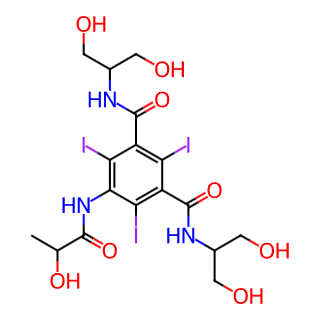- Synthetic anti-infective drugs
- Medications for the digestive system
- Antipyretic and analgesic drugs
- Medications for the blood system
- Medications for the respiratory system
- Anti-allergic drugs
- Medications for the urinary system
- Diagnostic medications
- Immunosuppressive and immunomodulatory drugs
- Vitamins and mineral supplements
- Antioxidants and medications for osteoporosis
- Antiparasitic drugs
- Ophthalmic medications
- Amino acids and their derivatives
- Dermatological medications
- Medications for the circulatory system
- Antitumor drugs
- Medications for the nervous system
- Hormonal and endocrine function-regulating drugs
- Antibiotics
- Others
CAS NO.: 60166-93-0




Basic Information
Chinese Name: 碘帕醇
English Name: Iopamidol
CAS Number: 60166-93-0
Molecular Formula: C17H22I3N3O8
Molecular Weight: 777.09
EINECS Number: 262-093-6
MDL Number: MFCD00867931
Chemical Properties
Solubility: Easily soluble in water, very slightly soluble in methanol, practically insoluble in ethanol (96%) and dichloromethane.
Density: 2.0203 (estimated)
Melting Point: >320°C (decomposes)
Boiling Point: 740.14°C (rough estimate)
pKa: 10.70 (at 25°C)
Uses and Characteristics
Uses: Iopamidol is a non-ionic water-soluble radiopaque contrast medium used in diagnostic imaging. It is a derivative of triiodinated isophthalic acid amides with low toxicity to blood vessel walls and nerves, good local and systemic tolerance, low osmolality, low viscosity, good contrast, stable injection solution, minimal in vivo deiodination, and suitable for patients with high-risk factors for contrast agent reactions. It is used for spinal cord contrast studies and in patients with high-risk factors for contrast agent reactions.
Excretion and Metabolism: After intravascular injection, iopamidol is primarily excreted through the kidneys. The half-life (T1/2) varies with renal function, typically ranging from 2 to 4 hours. Most (90%–95%) is excreted unchanged in urine within 7–8 hours, and almost 100% is excreted within 20 hours. Iopamidol is not metabolized in the body, does not bind to plasma proteins, and does not interfere with isoenzymes.
Clinical Applications
Iopamidol is used for various vascular contrast procedures, such as cerebral arteriography, cardiovascular angiography (including coronary, thoracic and abdominal arteries, peripheral arteries, veins, digital subtraction angiography), urography, arthrography, fistulaography, myelography, cisternography and ventriculography, and selective visceral angiography.
In CT scanning, iopamidol is also used for contrast-enhanced scans.
Storage Conditions
Iopamidol should be stored in a light-protected, sealed, and dry environment at a temperature of 2-8°C.

Tai Yau Street, San Po Kong, Kowloon, Hong Kong, China.



